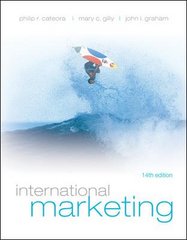Question
Part A: Draw a set of linear, U.S. domestic supply and demand curves for raw sugar with price, in cents per pound on the vertical
Part A: Draw a set of linear, U.S. domestic supply and demand curves for raw sugar with price, in cents per pound on the vertical axis, and quantity, in thousands of short tons of raw sugar on the horizontal axis. Include that graph here, including the labeling that you will do for parts 1.a through 1.d.
Part B: Assume that the international supply of raw sugar is perfectly elastic and that the world price for raw sugar, Pw, is constant at some price below the intersection of domestic supply and demand. Label your graph with the quantity that would be produced domestically without the TRQ, QS*, and the amount that would be consumed domestically without the TRQ, QD*. How much raw sugar would be imported without the TRQ?
Part C: Assume that the existence of the TRQ in the U.S. increases the price of imported raw sugar to PUS, but that the now higher sugar price in the U.S. is still below the intersection of domestic supply and demand. Label your graph with the quantity that would be produced domestically with the TRQ, QS,TRQ, and the amount that would be consumed domestically with the TRQ, QD,TRQ. How much raw sugar would be imported with the TRQ?
Part D: On your graph, shade or label the areas of welfare loss associated with the TRQ.
Part E: Complete the Benefit-Cost Analysis Tableau below with the appropriate areas that you labeled in part 1.d. from a policy that would eliminate the TRQ. Note that you are not entering dollar figures here, only indicating which areas represent gains and losses.

Step by Step Solution
There are 3 Steps involved in it
Step: 1

Get Instant Access to Expert-Tailored Solutions
See step-by-step solutions with expert insights and AI powered tools for academic success
Step: 2

Step: 3

Ace Your Homework with AI
Get the answers you need in no time with our AI-driven, step-by-step assistance
Get Started


